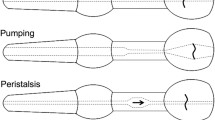Abstract
MANY rhythmic motor behaviours, including swimming1, walking2, scratching3, swallowing4, micturition5 and sexual climax6, are episodic: even in the absence of sensory inputs they exhibit a gradual run-down in frequency before spontaneously terminating. We have investigated whether the purinergic transmitters, ATP and adenosine, control run-down of swimming in the Xenopus embryo7. By using specific agonists and antagonists for the purinergic receptors, we have shown that ATP (or a related substance) is released during swimming and activates P2y receptors to reduce voltage-gated K+ currents and cause an increase in the excitability of the spinal motor circuits. Adenosine is also produced during motor activity, possibly through the actions of ectonucleotidases. The activation by adenosine of PI receptors reduces the voltage-gated Ca2+ currents, lowers excitability of the motor circuits, and so opposes the actions of ATP. A gradually changing balance between ATP and adenosine therefore seems to underlie the run-down of the motor pattern for swimming in Xenopus. We believe this to be the first time that ATP and adenosine have been found to be involved in motor pattern generation. The antagonistic interplay between these two transmitters may offer a general feedback mechanism that underlies run-down of all episodic motor patterns in vertebrates.
Similar content being viewed by others
References
McClellan, A. D. & Grillner, S. Brain Res. 269, 237–250 (1983).
Iwahara, T., Atsuta, Y., Garcia-Rill, E. & Skinner, R. D. Somatosens. Mot. Res. 8, 281–287 (1991).
Robertson, G. A., Mortin, L. I., Keifer, J. & Stein, P. S. G. J. Neurosci. 53, 1517–1534 (1985).
Jean, A. J. Autonom. Nerv. Syst. 10, 225–233 (1984).
Shefchyk, S. J. Neurosci. Lett. 99, 175–180 (1989).
McKenna, K. E., Chung, S. K. & McVary, K. T. Am. J. Physiol. 261, 1276–1285 (1991).
Wall, M. J. & Dale, N. J. Physiol. (Lond.) 487, 557–572 (1995).
Fredholm, B. B. et al. Pharmacol. Rev. 46, 143–155 (1994).
Lambrecht, G. et al. Eur. J. Pharmacol. 217, 217–219 (1992).
Hoyle, C. H., Knight, G. E. & Burnstock, G. Br. J. Pharmacol. 99, 617–621 (1990).
Gordon, E. L., Pearson, J. D. & Slakey, L. L. J. Biol. Chem. 261, 15496–15504 (1986).
Dale, N. J. Physiol. (Lond.) 489, 489–510 (1995).
Wall, M. J. & Dale, N. J. Neurophysiol. 72, 337–348 (1994).
Nieuwkoop, P. D. & Faber, J. Normal Tables of Xenopus laevis (Daudin) (North Holland, Amsterdam, 1956).
Kahn, J. A. & Roberts, A. J. Exp. Biol. 99, 185–196 (1982).
Dale, N. J. Physiol. (Lond.) 489, 473–488 (1995).
Dale, N. Eur. J. Neurosci. 3, 1025–1035.
Author information
Authors and Affiliations
Rights and permissions
About this article
Cite this article
Dale, N., Gilday, D. Regulation of rhythmic movements by purinergic neurotransmitters in frog embryos. Nature 383, 259–263 (1996). https://doi.org/10.1038/383259a0
Received:
Accepted:
Issue Date:
DOI: https://doi.org/10.1038/383259a0
- Springer Nature Limited
This article is cited by
-
Real-time measurement of adenosine and ATP release in the central nervous system
Purinergic Signalling (2021)
-
Purinergic signalling during development and ageing
Purinergic Signalling (2015)
-
Protective Effect of Spermidine Against Excitotoxic Neuronal Death Induced by Quinolinic Acid in Rats: Possible Neurotransmitters and Neuroinflammatory Mechanism
Neurotoxicity Research (2015)
-
Positive feedback loops sustain repeating bursts in neuronal circuits
Journal of Biological Physics (2011)
-
Purinergic signaling in embryonic and stem cell development
Cellular and Molecular Life Sciences (2011)





